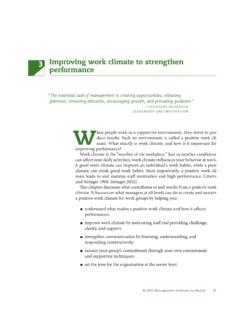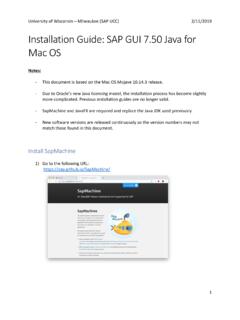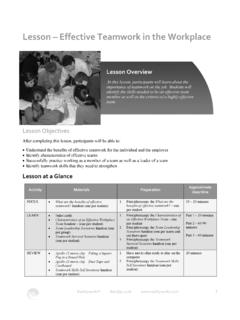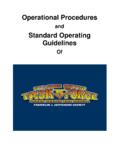Transcription of 4 Moving up the leadership ladder - WAHO | OOAS
1 4. Moving up the leadership ladder We turn out .. to realize our greater potentialities .. by viewing our own individual crises as opportunities to let go of who we have been, and to set forth on the journey toward becoming something more.. w i l l i a m br i d ge s t h e way of t r a nsi t ion W. hen someone moves to a higher position in an organization, this progression is called a leadership transition. People tend to think of leadership transitions as those that occur at the top level of an organization when the head of the organization leaves and a new person steps in. But leadership transitions take place at all levels of an organization, every time people move from one level to the next.
2 These transitions increase the person's scope of responsibility and accountability for the performance of increasingly larger parts of the organization. This chapter explores the ways in which your role changes as you move up the organizational hierarchy. It builds on the skills needed to develop a positive work climate and encourage strong team performance, and shows how these skills should be applied at each management level. We explore four typical levels of transition: becoming a rst-time manager who leads: Level One;. Moving from managing a team to managing other managers: Level Two;. becoming a senior manager: Level Three;. leading and managing at the top: Level Four.
3 This chapter also discusses the important role that managers at all levels have in grooming those below them to become competent managers who lead, so that there is a constant ow of quali ed people in the pipeline to take on increasingly more complex and senior roles in the organization. 2005 Management Sciences for Health 81. 82 managers who lead Building a pipeline of managers who lead The major job of leaders is to develop other leaders.. noel t ic h y t h e l e a der sh i p engi n e leadership transitions, except those at the very top, are often not very visible in an organization. Part of the reason for this is that when people move from one level of responsibility to a higher one, we rarely refer to those changes as leadership transitions.
4 More commonly, we call these transitions promotions. Technical In many cases, when people are promoted or move into new positions, expertise is they are not prepared to take on new management and leadership roles and not enough responsibilities. Outstanding technical expertise is often considered a su - cient quali cation for Moving someone into a managerial or leadership posi- tion. For example, good doctors and nurses are frequently promoted with little consideration of their management or leadership capabilities. When someone from the outside is hired, you may not realize that he is making a signi cant transition in taking a position with management and leadership responsibilities.
5 This may be a role that he is not fully prepared to handle, in spite of having excellent technical quali cations. Researchers who have studied the progressions of managers in organiza- tions have observed that job requirements are qualitatively di erent from one level to another (Jaques and Cason 1994). At each level, the time horizon (or scope of time that relates to the position's role in planning for the future) and the complexity of the job expand. These changes require increasingly com- plex mental processing abilities. Each transition When people work at levels that are above what they can handle (a time requires horizon and level of complexity that they cannot quite grasp), they are unable expanding to focus on their leadership and management tasks, and often do the work one's time they are most comfortable doing, which tends to be the work of a lower level.
6 Horizon As a supervisor, it is the manager's job to groom lower-level sta for taking on new management and leadership responsibilities, and when they are pro- moted, to support them so that they can perform well in their new role. grooming managers for leadership transitions Ram Charan introduced the image of a leadership pipeline and asserts that, if whatever is owing through it gets stuck, the pipeline will not deliver the resource it contains (Charan et al. 2001). Where the pipeline shifts direction, things can easily get stuck. It is the task of managers who lead to help those who get stuck to move on (up or out), and make room for others.
7 2005 Management Sciences for Health chapter 4 Moving up the leadership ladder 83. Organizations that recognize that people do not become great leaders over- night have instituted organizational practices that develop sta to take on increasingly complex leading and managing roles. In this way, organizations e ectively build a pipeline of leadership talent and support their sta in mak- ing these important leadership transitions. To keep the pipeline full with quali ed sta , it is critical that managers understand that at each level there are signi cant changes in the time hori- zon, priorities, relationships, and tasks people must deal with and di erences in the skills and management and leadership practices they need.
8 How suc- cessfully people adjust to these changes and di erences will determine how well they and others ow through the pipeline. In his book leadership without Easy Answers, Ronald Heifetz urges leaders to get o the dance oor and onto the balcony, where they can get a broader view of the scene below. At each subsequent transition, the manager moves up to the next balcony (see Figure 9). As the manager moves up in the hier- archy of the organization, the details of the people on the dance oor begin to recede, while the overall setting in which the dance takes place becomes more and more visible. This metaphor illustrates the challenge of managing leadership transitions: to make sure that the balconies (levels), the rhythm of the people who dance, and the beat of the music are all in harmony with one another.
9 Through the four levels of leadership transition presented in this chapter, we discuss the changes that are inherent in Moving up to the next balcony.. The tasks, capabilities, and shifts in mindset that are required to perform e ectively at each level are grouped into ve key areas, each of which becomes more complex as you move up the hierarchy: figure 9 From stage to balcony: A change in perspective .. Being at a higher level provides a different perspective and helps you see patterns that are not obvious at the ground level 2005 Management Sciences for Health 84 managers who lead Time horizon or time frame for which you need to plan and achieve results.
10 Priorities for your attention;. Types of relationships that you need to cultivate and manage;. Tasks or core responsibilities;. Leading and managing skills and practices that support high perfor- mance. Watch for signs Signs of derailment (presented in boxes in this chapter) indicate that the of derailment manager is not adequately performing at the requisite level and needs to improve his skills and practices before being considered for a higher-level position. It is the responsibility of the supervisor to see these signs and pro- vide support and coaching so that a manager can be competent and e ective. Since the transitions described in this chapter are generic, they might not quite t your speci c situation.






